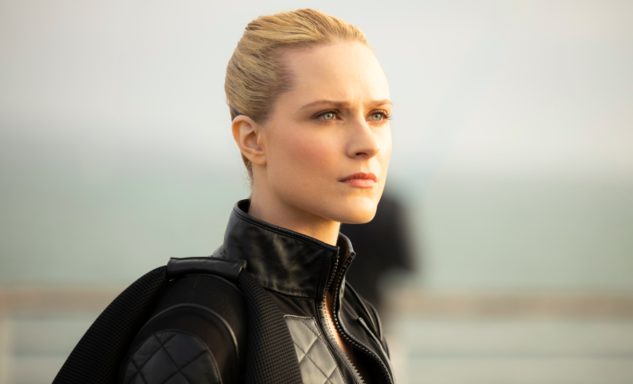Paste Power Rankings: The 10 Best TV Shows on Right Now, from Debras to Tales from the Loop
Illustration by Christine Fernando and Soleil Collins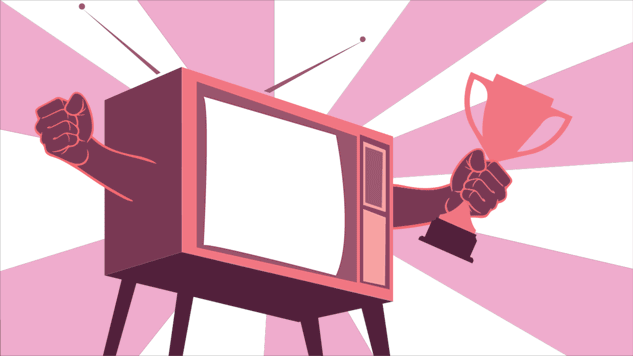
This week saw the farewells of two long-running series, Hawaii Five-0 and The Magicians, as well as the season (hopefully) finale of the sweet Miracle Workers. It also heralded the premieres of charming new series like Home Before Dark and Tales from the Loop.
But even with so much great TV—and there is, as noted below, more than enough of it—we at Paste have also found ourselves watching reruns, or at least shows that premiered awhile back. For our Editor-in-Chief Josh Jackson, it was a replay of the 2012 Premiere League final where Manchester City won their first title in generations against Manchester United. For me (your TV Editor Allison Keene), it was catching up on Babylon Berlin and Harlots. Whatever brings you comfort in these trying times!
One thing we can all agree on, though, is that John Krasinski’s weekly Some Good News show on YouTube is an absolute friggin’ delight. (This week, it featured the Skype reunion of the “Hamilton” cast).
The rules for the Power Rankings are simple: Any series on TV qualifies, whether it’s a comedy, drama, news program, animated series, variety show or sports event. It can be on a network, basic cable, premium channel, Netflix, Amazon, Hulu, YouTube or whatever you can stream on your smart TV, as long as a new episode was made available the previous week—or, in the case of shows released all at once, it has to have been released within the previous four weeks.
The voting panel is composed of Paste Editors and TV writers with a pretty broad range of tastes. We’re merciless: a bad episode can knock you right off this list. So much good TV is available right now.
Honorable Mention: Tiger King (Netflix), Dispatches from Elsewhere (AMC), The English Game (Netflix), One Day at a Time (Pop TV), The Plot Against America (HBO)
10. Three Busy Debras
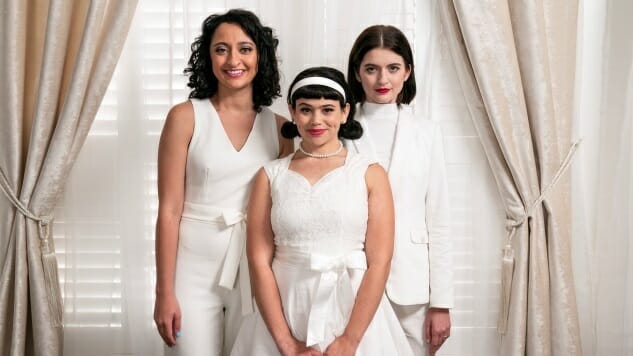
Network: Adult Swim
Last Week’s Ranking: Not Ranked
Three Busy Debras, an absurd parody of suburban privilege that premiered on Adult Swim in late March, bears many of the hallmarks of the channel it airs on. It’s short, it’s ridiculous, and it couldn’t really exist on any other network. Despite those surface similarities, it offers something that Adult Swim has openly struggled with for its entire history: it’s made by women.
Created by Sandy Honig, Mitra Jouhari and Alyssa Stonoha, who have performed live under the same name for years, Three Busy Debras is as surreal as you’d expect from an Adult Swim show. Its 12-minute episodes are basically short films that weave together two or three different comedy sketches built on a similar theme, with scenarios that are based in something resembling reality but always spiral out into absurdity. At the heart of this weirdness are the three Debras themselves, played by Honig, Jouhari and Stonoha. Dressed all in white, living in immaculately clean suburban homes that are practically identical from the outside, and all driving Escalades, the three Debras are busy with endless brunches where they laugh wildly at each other’s stories without actually listening to them. It digs deep into the vacuousness of these artificial suburban lives, as well as the selfish isolation of wealth and privilege, manifesting a clear political identity that’s both very timely and a bit weightier than the typical Adult Swim show.
The series’ entire ethos is summed up in a scene in a recent episode where two Debras, held captive in a comfortable bed that’s made entirely too well, explain that they’re obsessed with order and control and always have to be in charge because their lives are otherwise meaningless. The three Debras are terrible people, but it’s the society they live in that made them that way.
Yeah, you can call Three Busy Debras a cartoonish reflection of bourgeoisie anti-suburb displays like American Beauty or Desperate Housewives, which try to flatter and pander to the very audience they’re supposedly satirizing. That’d be selling the show short, though. It’s not just criticizing the culture it parodies—there’s not much skill or inspiration in that, after decades of similar TV shows, movies, and punk music videos. It takes on not just suburbia and the media that depicts it, but targets the socioeconomic conditions that created them—as well as our history-long subjugation and diminution of women—with a gleeful, nihilistic absurdity, wrapped around a core of weary indignation. And then it even makes fun of itself when it seems like it’s getting too close to a message. The Debras themselves might be afraid of their own humanity, but Three Busy Debras tacitly indulges in it. —Garrett Martin
9. Better Things
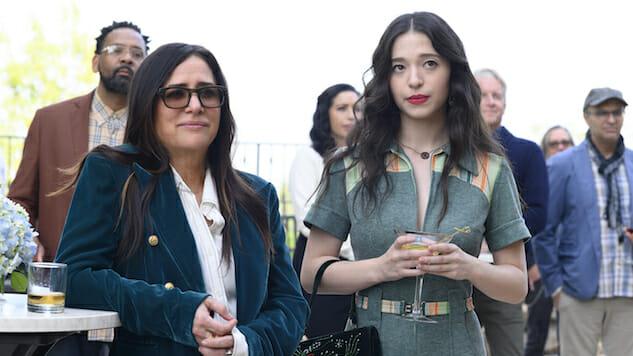
Network: FX
Last Week’s Ranking: Honorable Mention
Pamela Adlon’s dreamy FX series Better Things returns as biting and artful as ever. Sam (Adlon) continues to navigate life with her three young adult daughters, although the show’s best episodes are usually ones where she’s out on her own. From embracing a midlife crisis muscle car, to a strange and beautiful sojourn to New Orleans, to the constant cooking happening in her LA kitchen, Sam’s world is warm and funny and full of self-awareness. Adlon again directs the episodes the play out as flowing vignettes of life—the awkward, weird, funny, heartbreaking. Sometimes they connect, sometimes they don’t (which means you can really jump in any time). It’s a heightened view of reality that, even in its more surreal moments, still manages to capture something deeply truthful. —Allison Keene
8. Home Before Dark

Network: Apple TV+
Last Week’s Ranking: Not Eligible
Given how unkindly television and film routinely treat female journalists, it’s possible that Hilde Lisko, star Brooklynn Prince’s resolute lead in the new Apple TV+ series, Home Before Dark, might be just the kind of female journalist hero that we need right now. Inspired by award-winning crime reporter Hilde Lysiak, the character has an almost supernatural memory for detail, knows how to build up a rapport with local law enforcement (and decipher which ones she can trust), and isn’t afraid to stand up to established community leaders who may be hiding the truth.
She’s also nine.
Set amid a damp and murky small-town logging community that seems specially made to delight the likes of Special Agent Dale Cooper, Home Before Dark follows the Lisko family as they move to dad Matt’s (Jim Sturgess) childhood home from Brooklyn after he loses his newspaper job. This sets off a chain of events that has Hilde on the case of a potential massive cover-up of a child abduction in the 1980s that envelopes everyone from the sheriff and mayor to Hilde’s grandfather, dad, and school principal.
I appreciate that there is an effort, both by Prince and the writers, to make sure that Hilde is more than just some one-dimensional cute or precocious brat, and that there seems to be some serious fire in her veins when police officers initially dismiss her with a pat on the head. And do I indeed want to see—and do I want mine and other kids to see—an intrepid female reporter on the case? Yep. Do I wish that there were more adult versions of her on screen? Of course. But do I also wish the particulars of the job were handled more responsibly, especially in the era of fake news, and certainly if kids were going to watch? Uh huh. —Whitney Friedlander
7. Tales from the Loop
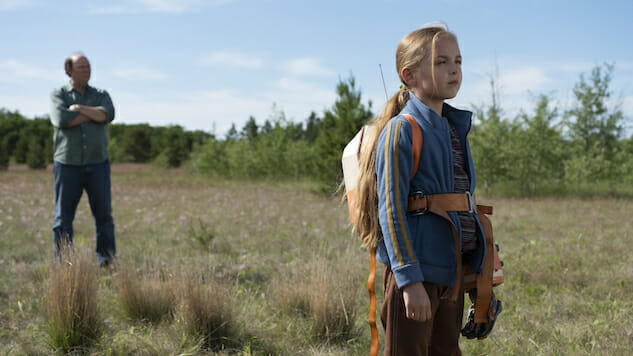
Network: Amazon Prime
Last Week’s Ranking: Not Eligible
A small town can become so self-contained and isolated, so self-involved in its own goings-on, that it can feel like a reality all its own. In Mercer, Ohio, the Midwestern setting of Amazon’s Tales from the Loop series, that feeling is magnified by a synecdoche of strangeness: The Loop, a device that’s fantastical physical function is left as vague as the intentions of its creator Russ (Jonathan Pryce). The thrumming black sphere at its center, locked beneath a concrete facility filled with scientists and mathematicians, makes the impossible possible. Life, otherwise, goes on. With limited explanation and an excess of empathy, the stark and lovely vignettes are a touching blend of intimacy and otherworldliness, like diary entries sent from an alternate dimension.
Creator Nathaniel Halpern adapts Swedish artist Simon Stålenhag’s sci-fi source of the same name, which blends alt-history anthropology and techno-archeology, into this reimagined and loosely linked anthology. Americanized to Ohio, the stories of Mercer play out like the Voyager’s Golden Records—teaching viewers from another world how the basic elements of life work in this realm. Memory, loss, regret, loneliness, even unrepentant horniness—Tales from the Loop skews less Black Mirror than it does the best episodes of Twilight Zone, where the genre setting merely kickstarts a more evocative piece of naturalist drama. Sometimes the sci-fi elements add layers and depth, but they often just support and color the humanity Halpern writes into the stories.
Ultimately, however, Tales from the Loop is that rare sci-fi show: one that trusts us to breathe in deep the oddities of its world, accept that we aren’t going to know everything, and climb aboard anyways. That trust, built with its tactful scene-setting and human-sized troubles, allows for easy investment in deceivingly simple dramas. If the rest of the episodes are as touching, moving, and casually engaging as what I’ve seen from The Loop, Amazon already has one of the year’s sharpest pieces of sci-fi. —Jacob Oller
6. Better Call Saul
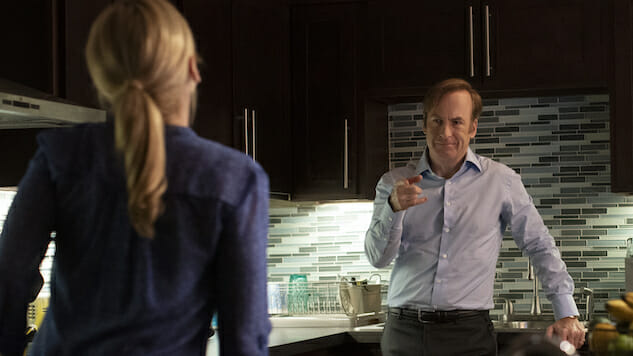
Network: AMC
Last Week’s Ranking: 2
It was only recently announced that Better Call Saul would be ending with its sixth season, though it wasn’t necessarily shocking news, given that with each passing year it’s been harder for one of TV’s best shows to ignore the future it’s been creeping towards. Season 5 is smart about how it acknowledges that, specifically in regard to increasing the Breaking Bad prequel’s engagement with what came canonically before but narratively after.
The final 13-episode season will mean that Saul will have run for 63 episodes, one more than Breaking Bad. Like everything else about this show, that was a deliberate choice. That said, Season 5 of Saul doesn’t necessarily feel like the beginning of the end. Instead, it’s more like the end of the beginning, given that after the events of the Season 4 finale, Jimmy McGill has now officially embraced the Saul Goodman identity—legally and professionally, at least.
Saul is the first persona we ever saw Bob Odenkirk wear in this universe, but thanks to the four seasons that have come before, we recognize it for the mask that it is. However, Jimmy seems to be getting more comfortable with wearing it, especially when this season pushes him to make some choices that prove reminiscent of his original introduction: In the words of Jesse Pinkman, “You don’t want a criminal lawyer… you want a ‘criminal’ lawyer.”
But Better Call Saul is a show whose fundamental foundation is built on the idea that every action has consequences, seen or unseen. In comparison to The Good Place, a show all about ethical debate, Better Call Saul isn’t searching for answers: The characters might debate ideas of moral relativism, but the sure and steady hand of creators Peter Gould and Vince Gilligan knows what is right and what is wrong—and it is never afraid to reveal what can happen when that line gets crossed. —Liz Shannon Miller
5. Little Fires Everywhere
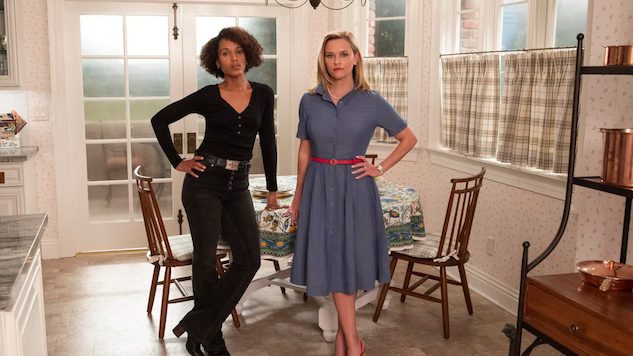
Network: Hulu
Last Week’s Ranking: 1
“You didn’t make good choices. You had good choices! Options that being rich and white and entitled gave you.”
That’s Mia (Kerry Washington) screaming to Elena (Reese Witherspoon) during the emotionally charged fourth episode of the new Hulu series Little Fires Everywhere.
The line sums up the crux of a series that explores the complicated themes of race, wealth, and motherhood with a delicate aplomb. Based on the Celeste Ng’s 2017 novel of the same name, the eight-episode series follows the sequence of events that occur when Mia moves to the storied community of Shaker Heights, Ohio with her teenage daughter Pearl (Lexi Underwood) in 1997.
Elena’s friend Linda (Rosemarie DeWitt) has struggled with infertility for years and has finally adopted a baby with her husband Mark (Geoff Stults). Their lives have been wrecked by miscarriages and still births. Their adopted daughter Mirabelle is the answer to years of prayer and heartache. Meanwhile, Mia’s co-worker Bebe (Huang Lu) decides to fight for custody of the baby she abandoned. The mother-focused stories continue, and eventually come to a boil: these proverbial “little fires everywhere” become harder and harder to extinguish as the series progresses.
The series is set in the 1990s but its themes, particularly those surrounding what defines motherhood, are timeless. The conversation around race and privilege are perhaps even more relevant today than the era in which the show is set.
Washington is fantastic as Mia. Her hard, angry exterior barely conceals her vulnerability. She’s a fiercely protective mother who may not always make the best choices but always wants what is right. Witherspoon has perfected the entitled character who is blind to her own entitlement, living a life that is so controlled and carefully cultivated that she may have even lost sight of what she truly wants in life. Together, these elements ignite to form a show well worth watching.—Amy Amatangelo
4. The Magicians
Network: Syfy
Last Week’s Ranking: 5
The Magicians finale had a little bit of everything that made the show so utterly itself. It tied beautifully back to Fillory and the Chatwin family, a time loop took viewers by surprise, and friends made sacrifices to save humanity (and all the other forms of life, like singing pigs and fairies). But most importantly, after five seasons of navigating trauma, mental health, and grief, The Magicians ended with hope.
Last season, The Magicians made a bold choice to kill off the oft-presumed main character of this fantasy journey. Grief may have changed some viewers’ relationship to the show, but it didn’t change The Magicians. The show remained snappy fun in between magical crisis after magical crisis. The Magicians has always been about trauma, grief, and pain, and Season 4 continued that journey in a cathartic and touching way as characters processed that death.
Those characters also kept trying, trying, trying to make themselves feel better. Margo and Eliot interacted with an actual brick wall in Fillory, but they and the other characters also hit a metaphorical one. They had to decide to either crash into their grief or let it go and run the other way. When something did go right and a character came back unharmed, it felt like such a relief I could have laughed. When another decided to remember the truth instead of lying or ignoring the pain, it was a revelation.
The Magicians was better than I ever imagined it could be. It was a constant surprise, it was a beautiful world to inhabit for a while, and I will miss it—just like Fillory itself. —Rae Nudson
3. Miracle Workers: Dark Ages
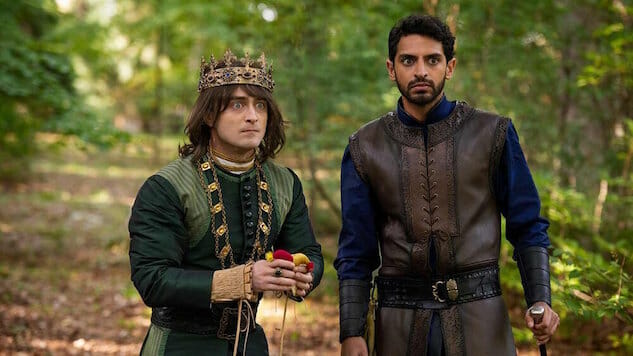
Network: TBS
Last Week’s Ranking: Honorable Mention
It feels like a miracle that Miracle Workers got a second season on TBS, but the fact that it’s as funny and strange as creator Simon Rich’s first oddball take on the afterlife should have comedy fans praising the heavens. This time around, Miracle Workers: Dark Ages (as the anthology series’ second entry is called) set its hilarious cast in another setting well-worn by comedies with a British pedigree: The Middle Ages. Breakout Geraldine Viswanathan is a Shitshoveler—literally, it’s her last name—whose dad (Steve Buscemi) and local layabout prince (Daniel Radcliffe) are always getting her into something … when she’s not breaking the mold by trying to, say, read. Monty Python and the Holy Grail is a good touchstone here, with everything from old-timey doctors to executions getting a light satirical jab. The humor is quick, witty, and understated, made even more unique by the brilliantly offbeat deliveries of its stars. If ever there was a show that felt like an Eddie Izzard stand-up routine turned into a series, it would be Miracle Workers, which—through its wonderfully sweet finale—contintined to be both one of the smartest and delightfully dumbest shows on TV. —Jacob Oller
2. Zoey’s Extraordinary Playlist
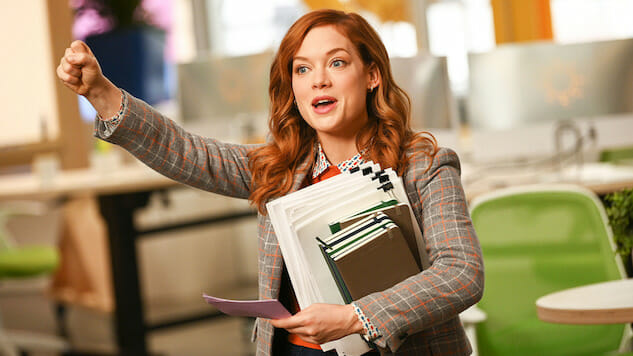
Network: NBC
Last Week’s Ranking: 8
Zoey’s Extraordinary Playlist is a pure delight. A show that is 1000% guaranteed to put a smile on your face, get your feet tapping and leave you humming a happy tune. I defy you to not be in a good mood after watching it. (Also this week: Hey ASL dancers!)
Jane Levy stars as the titular character who, after an MRI gone awry, can suddenly hear the soundtrack of people’s lives. Their innermost thoughts set to a Beatles song, a Whitney Houston ballad or a Katy Perry number. Because Zoey is privy to people’s innermost thoughts whether they are singing about sexual desire or loneliness or marital frustration, she tasks herself with solving their problems. But by adding the extra layer of full on, big musical numbers everything Zoey does seems natural. Musicals, by their very nature, require a huge willing suspension of disbelief.
The show also isn’t afraid to tackle big emotional problems from the sudden death of a parent to a husband who doesn’t respect you to being your true self to everyone. It’s NBC taking a risk. As far as musical TV series go, for every Glee or Crazy Ex-Girlfriend there’s a Cop Rock. For network television to be airing, promoting, financing a show like this is a sign that broadcast TV isn’t throwing in the towel to Netflix, Hulu, Amazon or (heaven help us) Quibi. NBC has come to play, thank you very much. And that’s something to sing about. —Amy Amatangelo
1. Westworld
Network: HBO
Last Week’s Ranking: 6
Even as a show known for twists, that was quite a twist this week.
More generally: The Hosts have left the murder-happy amusement park of carnal sin to give humanity a taste of its own medicine in Season 3 of HBO’s Westworld, where the mythical conflict of creator and creation continues to follow its tragic and violent course. Revolts against a progenitor pantheon—for example, in the Greek War of the Titans—rarely result in fuzzy feel-good fun for the victors (or those over which they rule), but like most things in the labyrinthine sci-fi, it’s the flavor rather than the fact that makes the show fun. While its ambitions have certainly changed since its first screenshot-able season encouraged fans to play Where’s Waldo in the forums, Westworld is still a good time with its looming war on the horizon—and it’s even halfway comprehensible this time around. Don’t worry! There’s still plenty to be confused about. Westworld is 100% back on its bullshit and, depending on how much you like your TV to be a rug-yanking crash course in skepticism, still presents beautiful illusion after beautiful illusion for you to doubt. Westworld at its most narratively accessible and visually unambitious. Season 3 may have expanded its story to a worldwide class conflict, but it still feels like its scope scaled down for the better as it hurdles towards a conclusion perhaps tragically predestined to reverse the power dynamics of the original park.—Jacob Oller
For all the latest TV news, reviews, lists and features, follow @Paste_TV.

